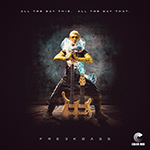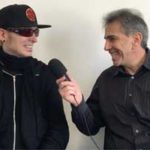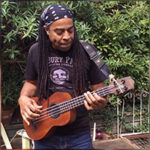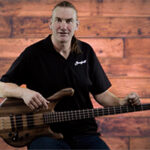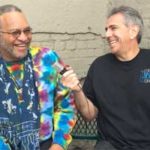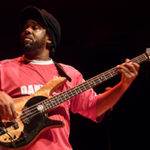Ohio funkmeister brings us up to speed on his latest musical and social media happenings
Exclusive interview with FBPO’s Jon Liebman
February 22, 2021
Bassist and vocalist Freekbass has deep connections with his hometown of Cincinnati, a legendary hotbed for funk music and funk musicians, dating back to the 1970s. True to his southwest Ohio roots, he’s steeped in the funk. He’s also worked alongside two of the genre’s all-time giants, bassmaster Bootsy Collins (who bestowed him with his stage name) and keyboardist Bernie Worrell. Beyond that, Freekbass has collaborated with artists representing a variety of styles, including Umphrey’s McGee, Sammi Garett, Turkuaz, Dumpstaphunk, George Porter Jr., Buckethead, DJ Logic, and Mike Gordon. An influential bassist in his own right, Freekbass has also appeared on a host of bass magazine covers and held master classes at numerous bass industry events. Over the years, Freekbass has released several solo albums, most recently All The Way This. All The Way That. When conditions permit, he tours with his band The Bump Assembly.
FBPO: The last interview you did with us was in 2016.
Freekbass: Wow!
FBPO: Bring us up to date on what’s been happening. I know you’ve been busy.
Freekbass: Yeah, well, a ton since 2016. Not too long after that, we signed with a really cool label. They’re called Color Red. They’re out of Denver, Colorado. The head A&R guy is Eddie Roberts. He’s from the band, The New Mastersounds, from the UK. We went out there and did our last album, and it was Eddie who produced it. It was our first vinyl. It was obviously digital and vinyl. The name of the album is All The Way This. All The Way That. Half the album was recorded at Color Red in their studios and produced by Eddie. The other half was produced by my friend, Itaal Shur. He wrote the song “Smooth” for Santana with Rob Thomas. They won the Grammy for that. He’s a big producer out of New York.
FBPO: Where did the title of the album come from?
Freekbass: The reason we called this album All The Way This. All The Way That was because the side of the album that Itaal produced was more kind of futuristic, what you think of in terms of the free bass sound. And then the other side of the album, which is kind of Color Red’s signature, was kind of more on that Blue Note side of things, where it’s a little more retro, early Funkadelic. We recorded everything live to tape, not virtual tape, but straight up real tape with all one takes and everybody recording at the same time. It’s a really, really cool record. That album came out about a year and a half, two years ago.
FBPO: It’s lucky you were able to get it out before things got so crazy all over the world.
Freekbass: Luckily right before the pandemic, we took another trip for the follow-up out to Colorado and recorded a ton of material. I guess it was January of last year, of 2020. And, when things looked like we were going to be off the road for quite a while, along with my management, I made the decision to release a single and a video once a month. I’ve been doing that literally every month since March or April last year. Literally one single along with an accompanying video. Some of the material we’ve done at Color Red, some of it, like this song I just recently did with Doug Wimbish. Stefan Lessard, the bass player from Dave Matthews and I are doing a track together. So I mean that’s going to be, literally, from now until somebody puts me in a straightjacket, it’s going to be a video and a song one per month.
FBPO: You mentioned you’re doing some of those in the studio. How are you doing the rest?
Freekbass: Well, obviously [for] the Color Red thing we were in the studio. The one where, for instance, the track that Doug and I did, Doug’s in Connecticut. I’m in Cincinnati, Ohio. We were basically trading files back and forth. Doug sent me some bass line he’d done with some cool beats. I did the same thing, and that’s kind of the way I’m doing with other people. With Stefan, same thing. Stefan’s [from] California, and so we’re just basically bouncing stuff back and forth. He’ll send me something. I’ll play something. I’ll send it back. And then I ended up mixing it. I mixed the dark thing at my studio, and then right now in the process of mixing the track that Stefan and I did together.
FBPO: It’s quite a commitment you made, to release a single and a video every month. Is there anything else you’re doing to occupy your time during COVID or is that pretty much eating up every second?
Freekbass: Well, that’s a big chunk of it, but two things actually. Since the pandemic started, on Saturday nights, I started going on my Facebook page live just to connect with fans to say, “Hello, how you doing?” And I would do it around the same time every Saturday night, 8:00 or 9:00 and then connect that way. And, so I missed one Saturday sometime in April, and I started getting people emailing me and they’re like, “Well, where were you last night?” I was like, “I was supposed to be off last night!” And so, long story short, it ended up becoming kind of a variety kind of talk show. I’ve been bringing different musical guests on every Saturday night at 9:00 p.m. Eastern time. It’s called Saturday Night Chit Chat. It’s a live stream. I’ve had everybody on from Victor Wooten to dUg Pinnick from King X to Jennifer Hartswick from Trey Anastasio’s band. Any guest you can think of. It’s kind of an interview style, but more of just musician to musician, just chit chatting. We’re doing it live on air, so I call it Saturday Night Chit Chat.
FBPO: That sounds like fun. What’s the other thing?
Freekbass: On Wednesday nights, I’ve been doing a Facebook Live, something called Wednesday Night Bass Talk, which also airs on my YouTube channel. It’s literally about 15, 20 minutes of just breakdowns of techniques, song breakdowns, new gear, or new unboxing. Anything bass related. That’s every Wednesday night at 9:00 p.m. on my Facebook page and YouTube. Just kind of keeping virtually connected with everybody, I guess, is the big theme.
FBPO: Tell me more about your gear.
Freekbass: I work with some amazing companies now, the amplifier company I’ve been with for the last two or three years, who I love to death, Gallien-Krueger. Forest Gallien, he’s just a great, great cat. I love combos. I know that’s a weird thing, but I love the stacking of combos on top of each other, visually, and also the way they sound and just the practicality of them. They had these new combos coming out and I just loved them to death. I played one at a music store before I ended up connecting with Gallien, so I’ve been with them ever since. They are just the greatest people in the world too, to work with. That’s my amplifier rig.
FBPO: How about basses? You’re still playing your Stonefield, aren’t you?
Freekbass: In terms of my basses, I’m still obviously working with Tomm Stanley from Stonefield. Since I’ve seen you, on top of the Freekbass signature model, he made a double-neck for me, which is a 4-string on the bottom. And on the top, it’s a 6-string piccolo bass. When we are playing live, I do a lot of loop station stuff, so I use that quite a bit during our set. I’m also working with a company out of Arizona called Eisenberg. Very unique shaped basses. We talked on Instagram and they made me kind of a Freekbass signature model. We call it the Pink Panther bass, because it’s a hot pink bass, which just kind of fits within our bag. And, it’s great. It’s all handcrafted by Steve Eisenberg, who went to one of the big luthier schools. He’s great.
FBPO: Anything else?
Freekbass: We’ve obviously got the Stonefield, the boutique, high-end version of the Freekbass signature model, but I wanted to work with a company where a kid, whether in high school, or fresh out of high school or just somebody, a newer bass student could get something in a lower price range, so they could afford. Jeff Moore, who’s the vice-president of ESP, got in contact with me and said he was a fan and would love to do something together. We’re kind of working through that right now. They sent me a prototype bass, which is their GB-4 bass, which is going to be kind of the template for my bass. We’re going to change some things around and make it the Freekbass signature model eventually. That just kind of happened recently in the last couple of months. There’ll be another. We’ll have more of a signature model with ESP people here some time within the next year or two.
FBPO: Getting back to Stonefield for a minute, the double-necks, how did you decide which neck would be on the top and which one would be on the bottom? Or does it matter?
Freekbass: Well, it does matter. I kind of left that to Tomm because, I didn’t know either, to be honest with you. The six-string being on bottom, because you’re doing more chords. It’s tuned just like a guitar. It’s just heavier gauged strings and I do a lot of chords on it. When you’re playing just the bass, which is in the normal position, it almost feels like you’re just playing a normal bass. I don’t know if there was any rhyme or reason behind that. I’m sure there is. Tomm’s very meticulous about that stuff, so I kind of left that in his hands. And then, he sent it over my way when it was done.
FBPO: What kind of strings are you playing?
Freekbass: I’ve been working with Dunlop for a long time, both with strings and pedals, but, just recently on top of that, there was a company called Dogonit Strings. They are releasing a Freekbass signature version of strings, which are going to be out probably in the next couple of weeks. They already started pre-orders on them at the beginning of the year. I’m going to be going down to the Dallas International Guitar Show to promote them, Covid-permitting, of course. They’re releasing a Freekbass signature kind of a model string with the gauges I use, .045 through .105. We kind of went through different trials and got some great things that could play both thumb style, but also finger style because I do a lot of that as well. They did some really cool packaging stuff too.
FBPO: What do you think is important for somebody who wants to learn bass? What do they need to know?
Freekbass: Well, I would say the most [important thing], right off the bat, is just doing it, taking that first step. I know that sounds like the obvious thing to say, but there are so many people out there that like, “I’d love to do this,” and, they keep figuring out ways to kind of talk themselves out of it. So just making that first step, purchasing a bass. It’s not like you have to go out and buy a $3,000 bass. Just go out and get something that’s affordable and just make a list of some bass players or songs, the style of music you want to learn, whether it be the Beatles, or maybe you’re more of a Rush person, or a funk person, whatever style it is. And, we start there.
FBPO: What next?
Freekbass: I would start by just trying to learn some very simple bass riffs, like two- or three-note bass riffs. When I teach, one of the first songs I always show students is “Papa Was a Rolling Stone” by the Temptations. It’s three notes, and it’s a classic song, and it’s fairly easy to do. Maybe only two or three riffs, so you see results quickly. That first lesson, that first time you play, it’s super gratifying if you can leave there playing something. Whether it be “Papa Was a Rolling Stone” or “Another One Bites the Dust” is another one that comes to mind. You can play it all on one string. Just try to learn something easy, quickly, so you see instant results.
FBPO: What about the future, Freek? I’ve known you for a while, and I’d bet there’s something you’re working on, another project. Am I right?
Freekbass: You are right! Without sounding too overly crazy and ambitious, we’ve talked about music and the visual. That’s always been kind of my thing. I was doing an interview with a radio station a couple of days ago, and I was just telling them how, as I was learning music, I was seeing music visually at the same time. I remember being like a little kid and it being way too late for me watching TV and squinting and seeing the “Ashes to Ashes” video. I didn’t know at the time it was David Bowie. As I was formulating my musicality, I was also formulating the visual that goes along with that. With that in mind, I’m definitely thinking of some kind of movie, and I’m not sure exactly what. I don’t know if it would be more fantasy, or if it will be more autobiographical. This is long-term, in the next three, four or five years.
FBPO: You mean to write it? To produce it? To star in it? All of the above?
Freekbass: All of the above. Yeah, all of the above. I’m sure Angie Wilson, who does all my videos, would be a huge hand in the direction side of things. She’s been doing my videos since “Love in Your Pocket.” She’s got an incredible eye.
FBPO: I remember when you did the Looking for the Bassmaker film with Tomm Stanley.
Freekbass: Yeah! The one in New Zealand! Yeah. Well, that was kind of like a mini version of the movie we’re talking about. That was for the Stonefield bass. Looking for the Bassmaker, which Tomm was playing multiple roles in. We filmed it all in Christchurch, New Zealand. That was a magical thing. That was so much fun doing that.
FBPO: So you’ve got some filmmaking experience.
Freekbass: And now, with the streaming world available, there’s a lot more options to get these types of projects off the ground. It’s not like you’re just relying on getting them into a handful of movie theaters across the United States. It’s more of a realistic thing, and I obviously want to tie some of the history of Cincinnati and the funk in there and maybe my journey. And of course not just my journey, but other people’s journeys along the way and the people that have influenced me. I almost see it as the Man Who Fell to Earth meets Eight Mile or something like that. I’m not sure yet. It’s all on the drawing board.
Freekbass’ lastest release, All The Way This. All The Way That, is available here:
All The Way This. All The Way That.
See Jon’s blog, with key takeaways from this interview here.

